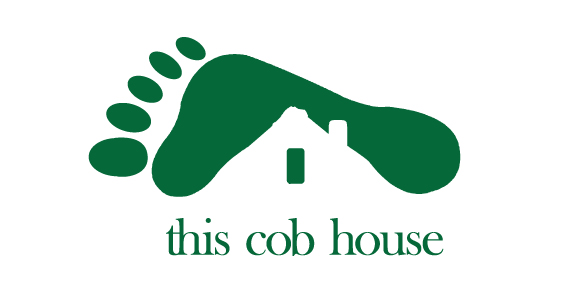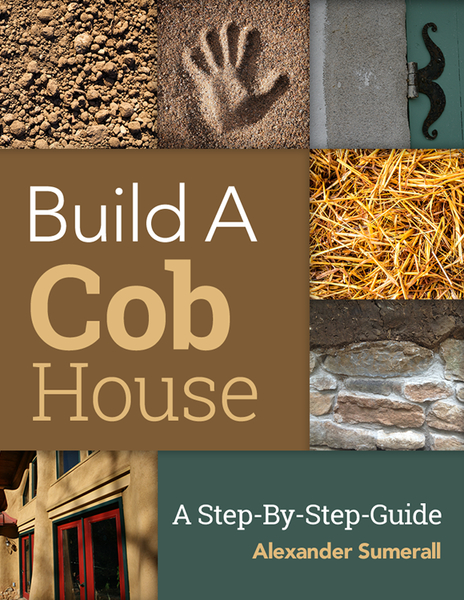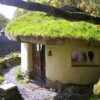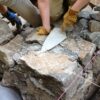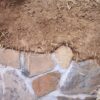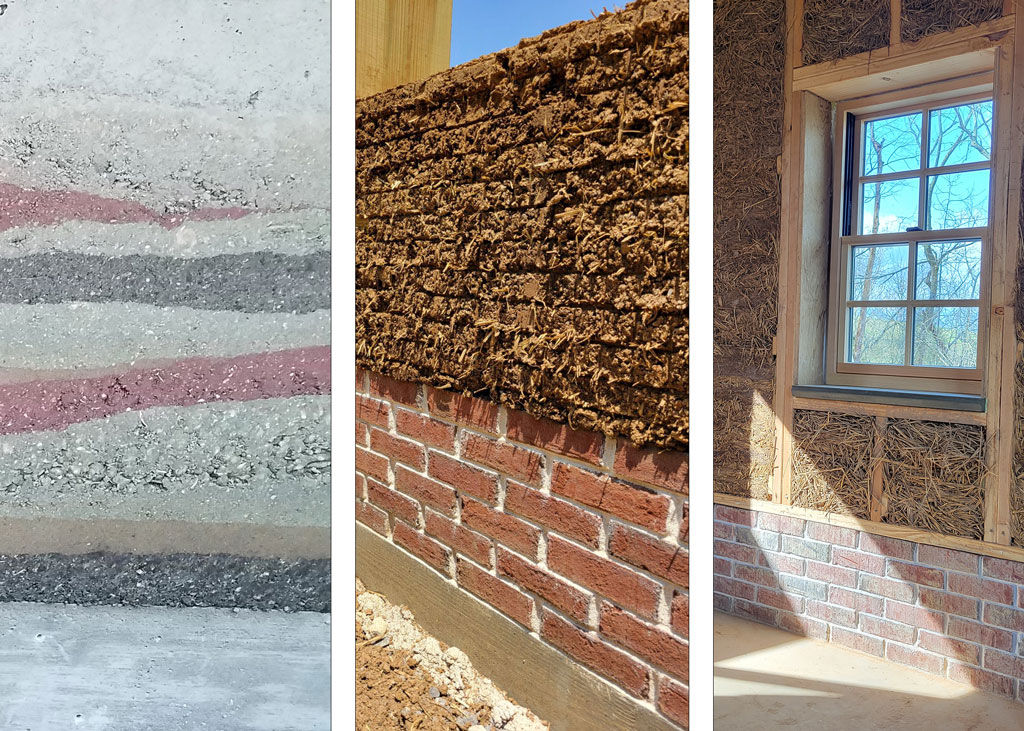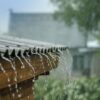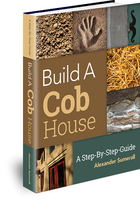Cob can’t be purchased in bags at the hardware store so you have to process the materials and make it yourself. The first step in making cob will be to find the proper ingredients.
You will need four basic ingredients to make cob:
1. Soil
2. Aggregate
3. Fiber
4. Water
All of these materials are widely available throughout the United States, Canada, the UK, Australia, New Zealand, Europe, and most of the world. There is a good reason that people have built with earthen materials all over the world since the dawn of civilization.
Soil
Cob is made from the soil right beneath your feet. Excavate the subsoil that lies beneath the thin layer of topsoil. This is one of the main ingredients for cob. The topsoil is the thin layer of dark dirt that contains mostly organic matter. The subsoil beneath has very little organic material and is where you’ll find the clay-rich soil suitable for cob. You will usually notice a very distinct change of color between the topsoil and the subsoil.
Many people have the misconception that you need to have clay to make cob. This is true, but you only need a soil that is roughly composed of 15-25% clay content. This is considered clay-rich soil. The rest of the soil is made up of sand, silt, and other aggregates. Using a pure clay would require you to add back in the 75-85% aggregate. It would not be practical and would require buying more sand to adjust it to the correct ratio. A heavy amount of clay in the soil is actually less desirable because it shrinks and cracks when it dries out and is unsatisfactory for earthen construction.
Soil for cob is generally easy to find in abundance and can generally be found all around the world. One good way to acquire the soil you need is to use what’s excavated from your foundation trenches. You can also look at construction sites where this excavated soil is considered a waste product and is hauled off to be dumped in landfills. This costs them a lot of money and they might just be happy enough to deliver it to you for free! You can also purchase truckloads of soil from soil depots or landscaping supply shops.
The clay is a binder and its purpose is to hold the sand (aggregate) together. The clay is composed of microscopic platelets that act as suctions between the aggregate particles when they’re made wet. Something important to understand is that clay expands when it’s made wet and it contracts when it’s dried out. This is why you can’t build a house out of pure clay. It needs the aggregate and straw fibers to give it stability and to prevent cracking.
This is also why, in reality, a cob house is more like a giant sand castle that is bound together in a unified mass by the clay particles.
Note: Some grassland areas of the Midwestern United States and sandy areas of the Florida peninsula have a lack of clay in their soils. These soils can be too loose and crumbly for optimal cob. This does not mean that you can’t find appropriate soils in these regions, but you may have to look harder than most. You can also have appropriate soil shipped in. Sandy soils in these regions can sometimes do well for rammed earth though.
Aggregate
The terms sand and aggregate can be used interchangeably, but most people refer to this ingredient as sand. The majority of your cob mixture is actually composed of sand and other aggregates found in the soil. It usually hovers somewhere around 80%. The other 20% is your clay. This ratio will differ depending on where you get your subsoil from though. That’s why the vast majority of times it’s going to be essential to add additional aggregate into your cob mixture. There are some rare areas where you will find soil that naturally contains the right amount of aggregate-to-clay ratio to make cob, but this is not usually the case.
One of the main guidelines for choosing sand for your cob mixture is to use a rough and coarse sand that has many different particle sizes included in it. A rough-edged sand helps the particles to lock together better and will prevent serious cracking. You may also opt for gravel aggregate as long as the gravel rocks are not bigger than about ¼ inch. Road base gravel, sometimes called crusher run gravel, also works very well for cob aggregate.
Rounded sand that is sometimes found on beach shores is not appropriate for cob because the particles don’t bond together with any strength. It’s like trying to stack a bunch of beach balls on top of each other, but they just keep rolling away.
If you live in the United States you will find sand for sale under many different names. Some common sands that you might encounter are masonry sand and concrete sand. These are typically used as ingredients for cement and are widely available. Sometimes they fall under different names by region of the country though.
Concrete sand is a great choice for cob. It is rough and holds a variety of particle sizes even including some small pebbles. Using this sand will help prevent serious cracking. Masonry sand is a finer version of concrete sand and is usually a bit too finely sifted for large cob constructions. I recommend either concrete sand or crusher run gravel.
You can buy sand or gravel inexpensively in large quantities by the truck load. You might spend a few hundred dollars for a truck load of sand plus the cost to transport it to your site, but the cost is still low considering that sand is one of the main ingredients in cob. The actual delivery charge can easily cost you more than the sand itself so it’s a good idea to order in bulk. You may have extra sand left over depending on what you’re building, but you can always use the extra sand for other projects. If you’re building a small cob house of a couple hundred square feet you might as well get a full dump truck load, which is usually between 6 to 10 cubic yards. Anything larger will require more than one truck load.
You can purchase sand and gravel at landscape supply depots and gravel yards. There is usually at least one for every small town or city in the United States so these businesses are easy to find.
Fiber
Straw is the component of cob referred to as the fiber. It acts as a natural rebar in a similar way that metal rebar would function in concrete. It adds tensile and shear strength to cob walls and holds a cob structure more together as a single monolithic piece.
Use straw that is fresh and not brittle or rotten. Make sure that it has been kept dry before purchasing it too. Sometimes a bale of straw might look okay on the outside, but it’s a good idea to examine some of the stock for mold or mildew by opening up a bale to see the inside portions. Look for bales of straw that have long strands. Six to twelve inches is an appropriate length. If it’s too short you are losing out on the benefits of this ingredient for cob.
Test the quality of straw by taking a strand in your hands and bending and pulling it to check it’s strength or brittleness. You can also take a couple more strands, put them all together, and try to tug the pieces of straw apart. Straw is much stronger when put together and it should be very difficult to break them with your own strength.
Many people are worried that the straw will rot inside of their cob walls over time. Straw and other similar fibers have been used in cob and there are many buildings that have lasted for hundreds of years without any decomposition of the fibers inside. Even after this much time, it’s still yellow and strong because there is very little oxygen or moisture available inside of dried cob for microorganisms to cause rotting and the straw is thus preserved inside.
Another important point to make here is that you should never use hay as a substitute for straw. They are very different things. Hay is a pre-harvest food product such as grass, alfalfa, or clover for livestock animals to eat. Straw is the post-harvest product that does not contain any food value. It is usually the stem left over from oats, wheat, or barley. Wheat stems are hollow and have great tensile strength.
On the other hand, hay has lower tensile strength and will quickly decompose. Hay has seeds in it and is still living, whereas straw is just the left over chaff and has no food value to it. As they say, “hay is for horses.” Don’t use it for cob!
Wheat straw is a great option for your fiber ingredient. It is widely available in the United States and many other countries. It usually costs between $3 to $5 for a bale. Oat and rye straws also make for strong cob fibers. You can find straw at farm feed stores, farmers, or sometimes at local home improvement stores such as Lowes or Home Depot. It’s also a good idea to search online for people selling straw bales locally.
Always try to store straw indoors. It’s risky to store it outdoors for any length of time. If you do keep it outdoors, store it up off the ground and keep it well ventilated. Covering your straw with tarps is good, but tarps usually leak and build up condensation underneath them. Store your straw underneath some leak-proof roofing material if you have it available. If you have sheets of plywood or steel roofing you can lay that on top to cover it. It’s very important to keep the straw dry to maintain its integrity.
Water
Water is the final ingredient that you will need for making cob. There’s nothing particularly special about the kind of water that you use though. If you’re getting it from your water lines then you have nothing to worry about. But if you’re collecting it from a pond or open body of water then perhaps just make sure that you remove any leaves or other organic matter from it first.
The water is a crucial ingredient in cob because it is what turns your soil, aggregate, and fiber into a doughy, thick building material. You may also remember that the clay first needs to be made wet in order to coat the aggregate particles and create the suction and binding.
